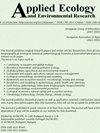灌水和综合施肥对玉米穗轴产量、营养品质和牧草生产力的影响
IF 0.6
4区 环境科学与生态学
Q4 ECOLOGY
引用次数: 0
摘要
. 植物养分和灌溉制度的优化具有促进玉米生长、玉米芯产量、牧草生物量和玉米创收的潜力。对双用途玉米进行了优化灌溉施肥管理的田间试验。试验包括4个灌溉方案,即不灌溉(I 0)、播种后20天一次灌溉(I 1)、播种后20天和40天两次灌溉(I 2)、播种后20天和60天三次灌溉(I 3)。施肥方案包括使用推荐剂量的肥料(RDF)(275-125-80-125-8千克/公顷-1氮、磷、钾、石膏和硫)(f1)、禽粪(PM)(5吨/公顷-1)(f2)、75% RDF + PM(2.5吨/公顷-1)(f3)和50% RDF + PM(5吨/公顷-1)(f4)。i3和f3组合在株高(177.72 cm)、带壳(8.36 cm)和无壳(1.62 cm)穗轴长(3.86 t ha -1)等大部分产量属性上均优于其他处理组合。该处理组合的玉米叶片和穗轴蛋白质含量也最高。但绿草产量最高的是I 1 ×F 1,与I 1 ×F 3持平,为29.99 t / h。从饲料收获到小玉米成熟,作物转换多花了20天。经济分析表明,i3 ×F 3处理组合产生的经济收益最大。本文章由计算机程序翻译,如有差异,请以英文原文为准。
COB YIELD, NUTRITIONAL QUALITY AND HERBAGE PRODUCTIVITY OF BABY CORN AS INFLUENCED BY IRRIGATION AND INTEGRATED NUTRIENT FERTILIZATION
. The optimization of plant nutrients and irrigation regimes hold potential to boost maize growth, cob yield, herbage biomass and revenue generation of maize. A field study was conducted to optimize irrigation and fertilization management for dual-purpose maize. The experiment was comprised four irrigation regimes viz. no irrigation (I 0 ), one irrigation 20 days after sowing (DAS) (I 1 ), two irrigations 20 and 40 DAS (I 2 ), and three irrigations 20, 40 and 60 DAS (I 3 ). The fertilization regimes included a treatment with recommended dose of fertilizers (RDF) (275-125-80-125-8 kg ha -1 of nitrogen, phosphorous, potassium, gypsum and sulfur) (F 1 ), poultry manure (PM) (5 t ha -1 ) (F 2 ), 75% RDF + PM (2.5 t ha -1 ) (F 3 ), and 50% RDF + PM (5 t ha -1 ) (F 4 ). Combination of I 3 and F 3 outperformed other treatment combinations in terms of most of the yield attributes such as plant height (177.72 cm), cob length with (8.36 cm) and without husk (1.62 cm), and cob (without husk) yield (3.86 t ha -1 ). This treatment combination also produced maize with the highest protein content of leaves and cobs. However, the highest green herbage yield (29.99 t ha -1 ) was recorded with I 1 ×F 1 , which remained at par with I 1 ×F 3 . It took 20 additional days for crop switching from fodder harvest to attain baby corn maturity. The economic analysis revealed that I 3 ×F 3 treatment combination generated the greatest economic revenue.
求助全文
通过发布文献求助,成功后即可免费获取论文全文。
去求助
来源期刊

Applied Ecology and Environmental Research
ECOLOGY-ENVIRONMENTAL SCIENCES
CiteScore
1.40
自引率
14.30%
发文量
104
审稿时长
14 months
期刊介绍:
The Journal publishes original research papers and review articles. Researchers from all countries are invited to publish pure or applied ecological, environmental, biogeographical, zoological, botanical, paleontological, biometrical-biomathematical and quantitative ecological or multidisciplinary agricultural research of international interest on its pages.
The focus is on topics such as:
-Community, ecosystem and global ecology-
Biometrics, theoretical- and quantitative ecology-
Multidisciplinary agricultural and environmental research-
Sustainable and organic agriculture, natural resource management-
Ecological methodology, monitoring and modeling-
Biodiversity and ecosystem research, microbiology, botany and zoology-
Biostatistics and modeling in epidemiology, public health and veterinary-
Earth history, paleontology, extinctions, biogeography, biogeochemistry-
Conservation biology, environmental protection-
Ecological economics, natural capital and ecosystem services-
Climatology, meteorology, climate change, climate-ecology.
The Journal publishes theoretical papers as well as application-oriented contributions and practical case studies. There is no bias with regard to taxon or geographical area. Purely descriptive papers (like only taxonomic lists) will not be accepted for publication.
 求助内容:
求助内容: 应助结果提醒方式:
应助结果提醒方式:


